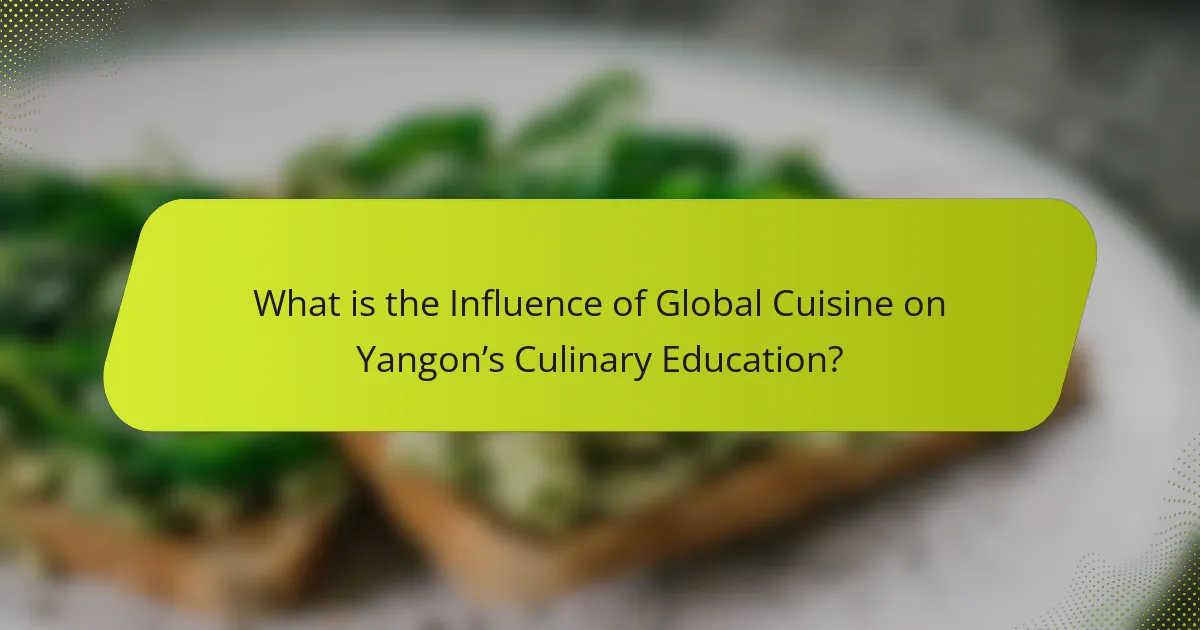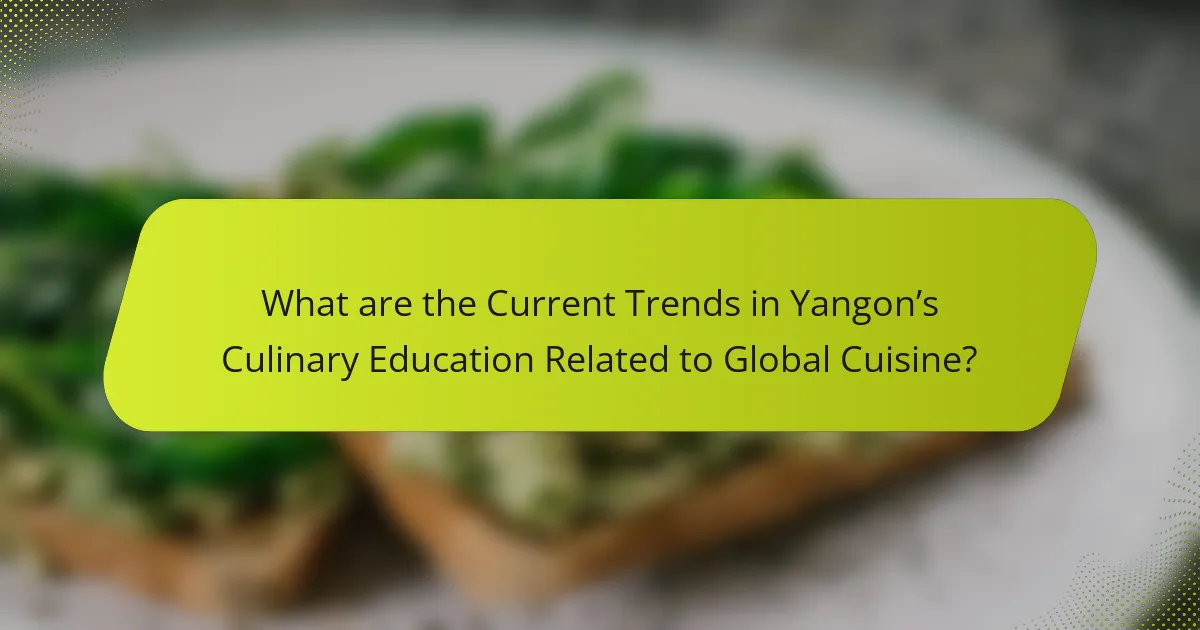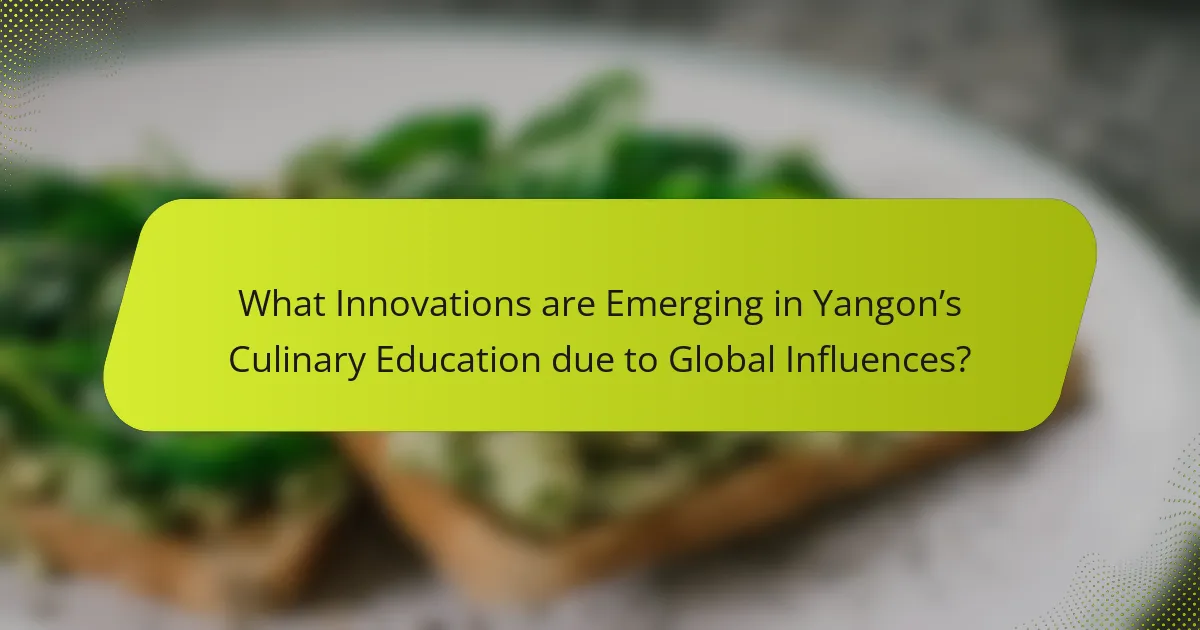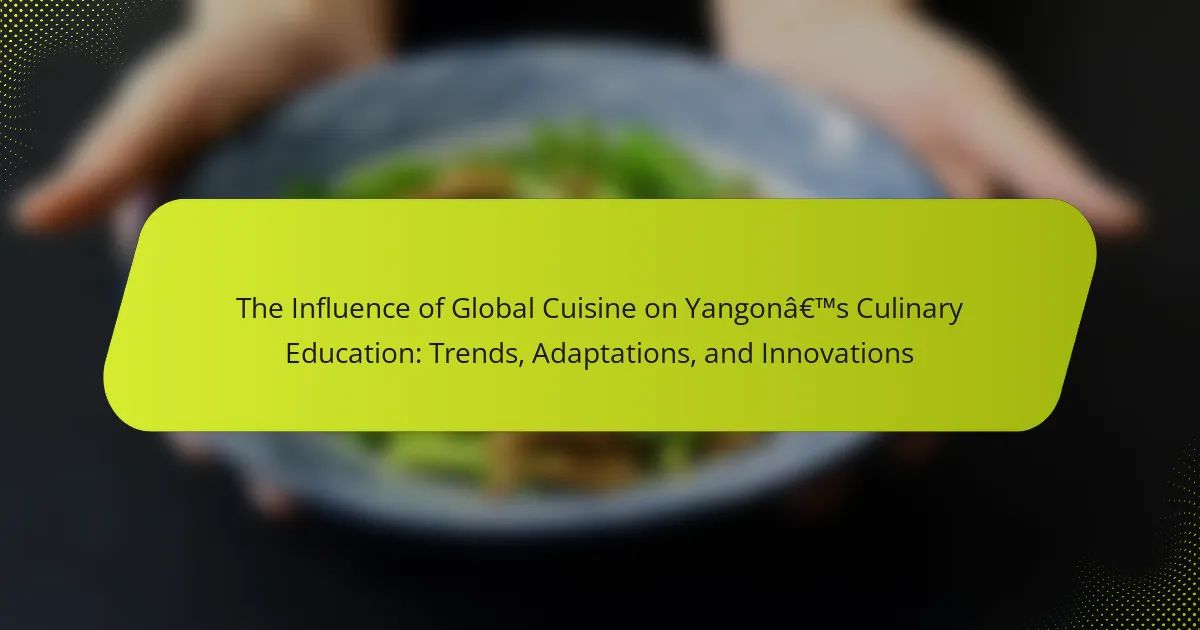The article examines the influence of global cuisine on culinary education in Yangon, Myanmar. It highlights how culinary schools are integrating diverse international cooking techniques and flavors into their curricula, enhancing students’ skills and creativity. The article discusses current trends such as the emphasis on fusion cuisine, partnerships with foreign culinary institutions, and the adoption of modern culinary technologies. Additionally, it addresses the growing interest in sustainable cooking practices and the impact of global culinary trends on local market demands. Overall, the article provides a comprehensive overview of the adaptations and innovations shaping culinary education in Yangon.

What is the Influence of Global Cuisine on Yangon’s Culinary Education?
Global cuisine significantly influences Yangon’s culinary education by introducing diverse cooking techniques and flavors. Culinary schools in Yangon incorporate international dishes into their curricula. This exposure enhances students’ skills and creativity. Chefs from various countries often conduct workshops and training sessions. These interactions provide hands-on experience with global culinary trends. Additionally, local restaurants increasingly feature fusion dishes that blend traditional Burmese cuisine with international elements. This trend reflects the growing demand for diverse culinary offerings in the market. Consequently, culinary education in Yangon evolves to meet these changing consumer preferences.
How has global cuisine shaped culinary education in Yangon?
Global cuisine has significantly influenced culinary education in Yangon by introducing diverse cooking techniques and flavors. Culinary schools in Yangon now incorporate international cuisines into their curricula. This integration enhances students’ skills in global culinary practices. For example, French, Italian, and Japanese culinary methods are now commonly taught. Such exposure prepares students for a competitive global market. Additionally, local chefs are increasingly blending traditional Burmese dishes with global influences. This fusion promotes innovation in local culinary practices. The growing popularity of international dining experiences in Yangon further drives this educational shift. Overall, global cuisine enriches the culinary landscape and educational frameworks in Yangon.
What are the key global culinary trends impacting Yangon?
Key global culinary trends impacting Yangon include plant-based diets, fusion cuisine, and sustainable sourcing. Plant-based diets are gaining popularity due to health and environmental concerns. This trend has led to increased demand for vegetarian and vegan options in local restaurants. Fusion cuisine combines elements from different culinary traditions, appealing to diverse tastes. This trend is evident in the blending of traditional Burmese flavors with international influences. Sustainable sourcing emphasizes local and organic ingredients. Many chefs in Yangon are adopting this practice to support local farmers and reduce carbon footprints. These trends reflect a broader shift towards health consciousness and sustainability in global culinary practices.
How do local culinary schools integrate global cuisines into their curricula?
Local culinary schools integrate global cuisines into their curricula by offering specialized courses focused on international cooking techniques. These courses often cover a variety of global cuisines such as Italian, Thai, and French. Instructors with diverse culinary backgrounds teach these classes, providing authentic insights into each cuisine. Schools also incorporate global ingredients and cooking methods in practical sessions. This hands-on approach allows students to experiment with flavors and techniques from different cultures. Additionally, culinary competitions and events often feature global themes, encouraging students to showcase their skills. Collaborations with international chefs further enhance the learning experience. These integrations reflect the growing demand for culinary professionals skilled in diverse cuisines.
Why is understanding global cuisine important for culinary students in Yangon?
Understanding global cuisine is important for culinary students in Yangon because it enhances their culinary skills and creativity. Exposure to diverse culinary traditions broadens their perspective on flavors and techniques. This knowledge allows students to innovate and adapt local dishes. Global cuisine can also attract tourists, boosting the local economy. Familiarity with international trends helps students stay competitive in the job market. Additionally, it fosters cultural appreciation and understanding. Culinary schools in Yangon incorporate global cuisine into their curriculum to prepare students for a globalized industry.
What skills do students gain from studying global cuisines?
Students gain various skills from studying global cuisines. They develop culinary techniques that are diverse and culturally significant. Students learn about ingredient sourcing and the importance of freshness. They acquire knowledge of flavor profiles and how to balance them. Studying global cuisines enhances teamwork skills through collaborative cooking projects. It fosters creativity in recipe development and presentation. Students also gain cultural awareness and appreciation for global traditions. Understanding food safety and hygiene practices is another critical skill obtained.
How does exposure to global cuisine enhance creativity in culinary practices?
Exposure to global cuisine enhances creativity in culinary practices by introducing diverse flavors and techniques. This exposure encourages chefs to experiment with new ingredients and cooking methods. It broadens their culinary perspective beyond traditional boundaries. Chefs can blend different cultural influences, resulting in unique dishes. For example, fusion cuisine combines elements from various culinary traditions. Studies show that such experimentation leads to innovation in menu development. A 2020 report from the Culinary Institute highlighted that 75% of chefs believe global influences inspire new ideas. This creative process ultimately enriches the culinary landscape.
What challenges do culinary educators face in incorporating global cuisine?
Culinary educators face several challenges in incorporating global cuisine. Limited resources can hinder access to diverse ingredients. Students may lack familiarity with various global cooking techniques. Cultural differences can create misunderstandings in culinary practices. Time constraints in curriculum restrict the depth of global cuisine exploration. Additionally, educators may struggle with balancing traditional and modern culinary methods. There is also a need for professional development to stay updated on global trends. These challenges can impact the effectiveness of teaching global cuisine in culinary programs.
What are the cultural barriers to adopting global culinary practices?
Cultural barriers to adopting global culinary practices include traditional beliefs, food taboos, and local preferences. Traditional beliefs often dictate what ingredients and cooking methods are acceptable. Food taboos can restrict the use of certain ingredients based on cultural or religious practices. Local preferences shape the demand for familiar flavors and dishes, making it difficult for global cuisines to penetrate the market. Additionally, a lack of exposure to global culinary practices can hinder acceptance. Education and awareness are crucial for overcoming these barriers. Research shows that culinary education can play a significant role in promoting global cuisine acceptance.
How do resource limitations affect the teaching of global cuisines?
Resource limitations significantly hinder the teaching of global cuisines. Limited access to diverse ingredients restricts the authenticity of culinary education. Insufficient funding affects the availability of equipment necessary for specialized cooking techniques. A lack of trained instructors in global cuisines diminishes the quality of education. Additionally, inadequate facilities can limit hands-on learning experiences. These factors collectively reduce students’ exposure to various culinary traditions. Consequently, this impacts their ability to innovate and adapt global cuisines in their local context.

What are the Current Trends in Yangon’s Culinary Education Related to Global Cuisine?
Current trends in Yangon’s culinary education focus on integrating global cuisine into local training programs. Culinary schools are incorporating international cooking techniques and ingredients. There is an emphasis on fusion cuisine, blending traditional Burmese flavors with global influences. Programs are also adopting modern culinary technologies and practices. Partnerships with foreign culinary institutions are becoming more common. This enhances exposure to diverse culinary styles and methodologies. Additionally, there is a growing interest in sustainable and ethical cooking practices. These trends reflect a shift towards a more global perspective in culinary education in Yangon.
How are modern culinary trends influencing educational practices in Yangon?
Modern culinary trends are significantly influencing educational practices in Yangon. Culinary schools are incorporating international cuisines into their curriculums. This integration reflects the growing popularity of diverse food cultures. Students are learning techniques from global culinary practices. Programs now emphasize sustainability and local ingredients. This focus aligns with worldwide trends towards healthier eating. Collaborations with international chefs enhance practical learning experiences. Industry partnerships provide students with real-world insights and opportunities.
What specific global cuisines are gaining popularity among culinary students?
Asian cuisines, particularly Thai and Japanese, are gaining popularity among culinary students. These cuisines are known for their unique flavors and presentation. Thai cuisine offers a balance of sweet, sour, and spicy elements. Japanese cuisine emphasizes fresh ingredients and meticulous preparation. Additionally, Mediterranean cuisine is also trending. It is celebrated for its health benefits and diverse ingredients. Culinary schools are incorporating these cuisines into their curricula. This reflects a growing interest in global culinary techniques and flavors. Students are eager to learn about international food trends.
How are international partnerships enhancing culinary education in Yangon?
International partnerships are enhancing culinary education in Yangon by providing access to global culinary techniques and resources. These collaborations often involve renowned culinary schools and chefs from various countries. They facilitate knowledge exchange through workshops, training sessions, and internships. Students gain exposure to international cuisines and cooking methods. This experience improves their culinary skills and broadens their culinary perspectives. Additionally, partnerships often lead to curriculum development that incorporates global standards. Research has shown that such initiatives significantly improve student employability in the hospitality industry. Overall, international partnerships are crucial in modernizing and enriching culinary education in Yangon.
What role does technology play in culinary education regarding global cuisine?
Technology plays a crucial role in culinary education regarding global cuisine. It enhances access to diverse culinary resources. Online platforms provide students with global recipes and techniques. Virtual classrooms enable interaction with international chefs. Mobile applications offer cooking tutorials from various cultures. Advanced kitchen equipment allows for experimentation with global flavors. Technology facilitates the study of food science and nutrition. It also supports collaboration among culinary institutions worldwide. These advancements prepare students for a global culinary landscape.
How are online resources and platforms used for teaching global cuisines?
Online resources and platforms are utilized for teaching global cuisines through various methods. These platforms provide access to instructional videos, recipes, and cooking tutorials. Websites and apps like YouTube, MasterClass, and Coursera offer courses on international cooking techniques. Interactive forums and social media allow students to share experiences and ask questions. Online cookbooks and blogs present diverse culinary traditions in an accessible format. Virtual cooking classes enable real-time interaction with chefs and culinary experts. Research indicates that online learning increases engagement and accessibility for culinary students. This trend reflects a broader shift towards digital education in culinary arts.
What technological innovations are being adopted in culinary schools?
Culinary schools are adopting various technological innovations to enhance education. These include virtual reality (VR) for immersive cooking experiences. VR allows students to practice skills in a simulated environment. Additionally, 3D food printing is gaining traction in culinary education. This technology enables the creation of intricate food designs. Smart kitchen appliances are also being integrated into curricula. These appliances provide real-time data and improve efficiency in cooking. Online learning platforms facilitate remote education and access to diverse culinary techniques. Furthermore, mobile apps are being used for recipe management and skill tracking. These innovations collectively improve student engagement and learning outcomes in culinary schools.

What Innovations are Emerging in Yangon’s Culinary Education due to Global Influences?
Innovations in Yangon’s culinary education include the integration of international cuisines and modern cooking techniques. Culinary schools are adopting global culinary standards and curriculum frameworks. This includes training in French, Italian, and Asian fusion cuisines. Additionally, there is an emphasis on sustainability and local sourcing of ingredients. Technology is also being incorporated, with online classes and digital resources becoming common. Partnerships with international culinary institutions are enhancing skill development. These innovations reflect a response to the growing global culinary trends and local market demands.
How are culinary schools in Yangon innovating their teaching methods?
Culinary schools in Yangon are innovating their teaching methods by incorporating technology and global culinary trends. They utilize online platforms for interactive learning and virtual cooking classes. Schools are also emphasizing hands-on experience through partnerships with local restaurants. This approach allows students to gain real-world skills. Additionally, they are integrating international cuisines into the curriculum. This adaptation reflects the growing diversity of culinary influences in the region. Evidence of this innovation can be seen in the increased enrollment in specialized courses focusing on global culinary techniques.
What new courses or programs are being developed to reflect global influences?
New courses and programs are being developed to integrate global culinary influences into Yangon’s culinary education. These programs include modules focusing on international cuisines such as Italian, Japanese, and Indian. Culinary schools are collaborating with global chefs to design these courses. Additionally, hands-on workshops are being introduced to teach authentic cooking techniques. This approach aims to enhance students’ understanding of diverse culinary traditions. The curriculum also emphasizes the use of global ingredients in local recipes. This trend reflects the increasing globalization of culinary arts in education. Such initiatives prepare students for a competitive international culinary landscape.
How are hands-on experiences being integrated into culinary education?
Hands-on experiences are integrated into culinary education through practical training in kitchen labs and real-world culinary settings. Students participate in cooking classes that emphasize skill development. They learn techniques by preparing various cuisines, reflecting global culinary trends. Internships and externships provide exposure to professional kitchens. Collaborations with local restaurants enhance practical learning opportunities. These experiences foster creativity and adaptability in students. Research indicates that hands-on training improves retention and skill mastery in culinary students.
What best practices can culinary educators adopt to enhance global cuisine education?
Culinary educators can enhance global cuisine education by incorporating diverse culinary traditions into the curriculum. This includes teaching authentic cooking techniques from various cultures. Educators should also invite guest chefs from different backgrounds to share their expertise. Hands-on workshops can provide students with practical experience in global cuisines. Collaborating with international culinary institutions can expand resources and knowledge. Utilizing technology, such as virtual cooking classes, allows for global participation. Additionally, integrating cultural history and context enriches the learning experience. Research shows that exposure to diverse cuisines fosters creativity and adaptability in culinary students.
How can collaboration with local restaurants improve culinary training?
Collaboration with local restaurants can significantly enhance culinary training. It provides students with real-world experience in a professional kitchen environment. This exposure allows students to apply theoretical knowledge in practical settings. Working alongside experienced chefs fosters skill development and creativity. Additionally, students gain insights into current industry trends and customer preferences. Such partnerships can also lead to mentorship opportunities. Local restaurants may offer internships or job placements for trainees. This connection between education and industry ensures that training is relevant and up-to-date.
What methods can be used to assess students’ understanding of global cuisines?
Methods to assess students’ understanding of global cuisines include practical cooking assessments, written tests, and presentations. Practical cooking assessments evaluate students’ ability to prepare dishes from various cuisines. Written tests can cover culinary terminology, history, and cultural significance of global cuisines. Presentations allow students to explore and share insights about specific cuisines or dishes. Observational assessments during group activities can also provide insights into students’ collaborative skills and knowledge application. These methods collectively ensure a comprehensive evaluation of culinary understanding.
The main entity of the article is the influence of global cuisine on Yangon’s culinary education. The article explores how international culinary practices are integrated into local educational frameworks, highlighting trends such as plant-based diets, fusion cuisine, and sustainable sourcing. It discusses the challenges faced by culinary educators, the role of technology, and the importance of hands-on experiences in enhancing student skills. Additionally, the article examines the impact of global culinary trends on curriculum development and the collaboration between culinary schools and local restaurants to prepare students for a competitive global market.
